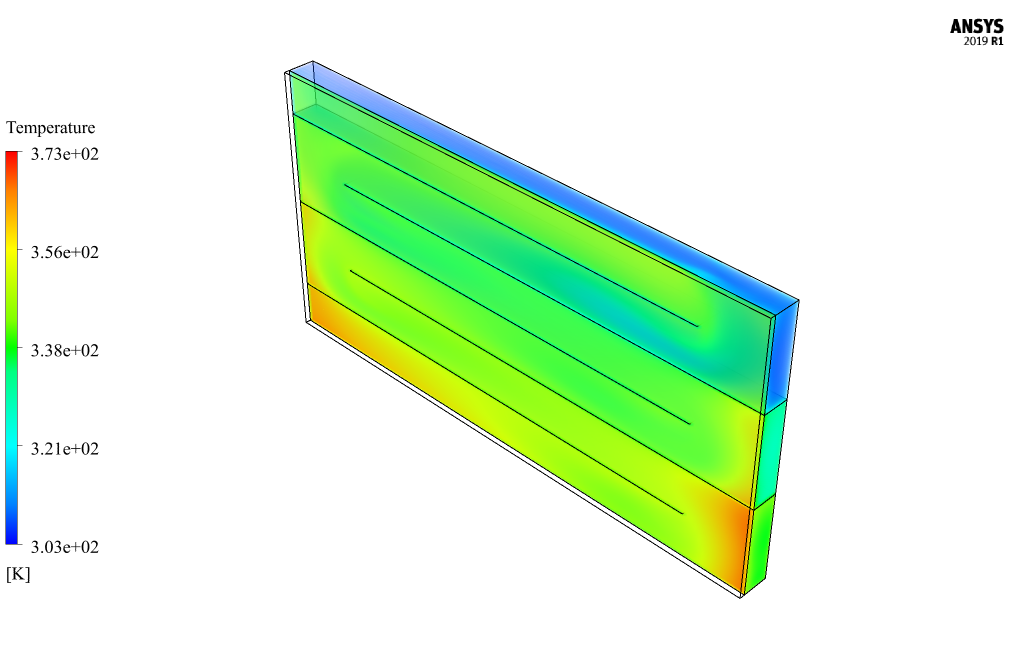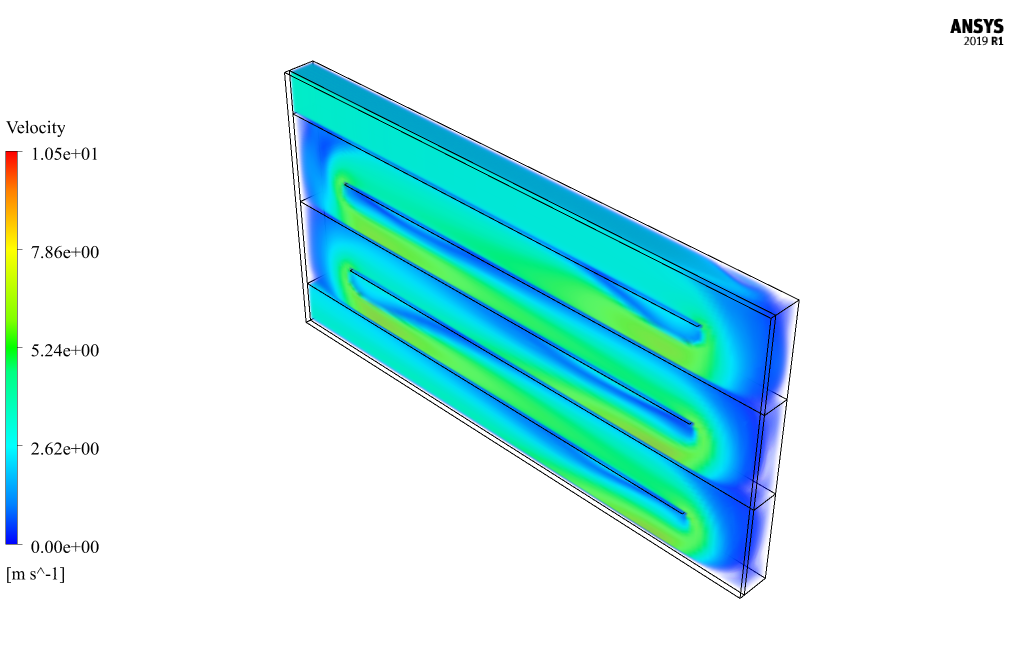Solar Heat Exchanger, ANSYS Fluent CFD Simulation Tutorial
$140.00 $70.00 Student Discount
- The problem numerically simulates the Solar Heat Exchanger using ANSYS Fluent software.
- We design the 3-D model by the Design Modeler software.
- We Mesh the model by ANSYS Meshing software, and the element number equals 304200.
- We use Discrete Ordinates (DO) and Solar Ray Tracing to consider radiation heat transfer.
To Order Your Project or benefit from a CFD consultation, contact our experts via email (info@mr-cfd.com), online support tab, or WhatsApp at +44 7443 197273.
There are some Free Products to check our service quality.
If you want the training video in another language instead of English, ask it via info@mr-cfd.com after you buy the product.
Description
Description
This simulation is about a solar heat exchanger via ANSYS Fluent software. We perform this CFD project and investigate it by CFD analysis.
This system consists of two parts: the water flow moves in the central part of the heat exchanger, and the airflow is in the gap located in the front plate of the heat exchanger.
The water flow enters the heat exchanger at a velocity of 4 m/s and a temperature of 30 ° C and leaves the heat exchanger at atmospheric pressure. The heat exchanger absorber wall is exposed to solar radiation and absorbs heat through radiant heat transfer.
This means the air gap temperature in front of the absorber plate rises as the sun heats up. This increase in air temperature causes heat to be transferred to the absorber plate, and subsequently, heat is transferred from the absorber plate to the water flow inside the heat exchanger.
Therefore, the water flow inside the system increases with the temperature received by the absorber plate. Also, to enhance heat transfer, several rows of inner walls are designed as a barrier inside the heat exchanger to prolong the water flow and increase the chance of contact with the absorber plate.
The geometry of the present model is drawn by Design Modeler software. The model is then meshed by ANSYS Meshing software. The model mesh is unstructured, and 304200 cells have been created.
Solar Heat Exchanger Method
The radiation model is used to define radiation heat transfer, and the defined Radiation model is discrete ordinates (DO). The discrete ordinates model is used for cases where the radiation heat transfer equations are solved for a finite number of discrete solid angles.
This model is the most comprehensive radiation model. It is used for scattering light, semi-transparent environments, glossy surfaces such as mirrors, and wavelength-dependent transitions.
Also, the solar ray tracing model has been used to apply solar load on the heat exchanger. The amount of direct solar radiation is defined as 1150 W.m-2, the amount of diffuse solar radiation is defined as 80 W/m2, and the direction of the sun’s rays is perpendicular to the absorber plane.
Solar Heat Exchanger Conclusion
After simulation, 2D and 3D contours related to pressure, velocity and temperature are obtained. The results show that the water flow temperature increases from the inlet section to the outlet section.
These temperature changes indicate that the radiation heat transfer and the effect of the solar ray tracing are completely applied to the heat exchanger absorber plate and, consequently, to the water flow.














Suzanne VonRueden –
Does this simulation account for the effects of radiation on heat transfer?
MR CFD Support –
Yes, the simulation takes into account the effects of radiation on heat transfer. The energy equation used in the simulation includes a term for radiative heat transfer, allowing for accurate prediction of heat transfer in solar heat exchangers.
Prof. Liana Berge Jr. –
Is there a way for me to contribute to this simulation?
MR CFD Support –
We welcome contributions! Feel free to share your ideas or suggestions.
Maxine Tillman IV –
Can the results of this simulation be used to reduce the cost of solar thermal energy?
MR CFD Support –
Yes, the results of this simulation can provide valuable insights into the performance of solar heat exchangers. These insights can be used to optimize the design and operation of these systems, thus reducing the cost of solar thermal energy.
Raymundo Stamm –
I’m delighted with the simulation outcome of the temperature increase! It vividly shows the heat transfer is efficient. Nice work!
MR CFD Support –
Thank you for your positive feedback! We’re thrilled to hear that you’re satisfied with the simulation results and that you found the heat transfer process in the solar heat exchanger impressively efficient. If you have any further questions or need additional information on how we generate these results, we’re always here to help.
Miss Angeline Miller III –
Just wanted to say that the rate of temperature increase in the water flow is impressive!
MR CFD Support –
Thank you for your positive feedback! We’re glad to hear that the simulation results were to your satisfaction and demonstrated the effective heat transfer in the solar heat exchanger model. If you have any further questions or require assistance with another CFD project, feel free to reach out. We’re here to help!
Reginald Effertz –
The tutorial was incredibly detailed and showed palpable temperature changes through the system, indicating successful heat transfer thanks to the solar tracing implementation. I learned a lot about the effect of radiation modeling on the efficiency of a solar heat exchanger. A useful skill set for my projects!
MR CFD Support –
We’re thrilled to hear you found the Solar Heat Exchanger tutorial valuable and that it has helped you with your projects! Our goal is to provide quality education, and we appreciate your feedback confirming the effectiveness of our CFD simulations. Thank you for choosing MR CFD for your learning journey!
Dr. Dexter Baumbach –
The careful engineering replicated in this CFD simulation of a solar heat exchanger is awe-inspiring. The focus on trajectories and discrete ordinates to model the way radiative solar heat affects the system is cutting-edge and mirrors the complexity of real-world thermal phenomena. An exceptional tutorial indeed!
MR CFD Support –
We truly appreciate your kind words highlighting the depth and precision of the CFD modeling in our solar heat exchanger tutorial. It’s rewarding to know that our efforts to create a realistic and comprehensive tutorial resonate with our customers. Thank you for taking the time to share your experience!
Merritt Olson –
I appreciated learning how different heating elements within a heat exchanger interact through the sunny solar heat exchanger simulation. The tutorial was easy to follow, and the discrete ordinates model gave a clear understanding of radiation heat transfer. Thanks for such a well-structured learning experience!
MR CFD Support –
Thank you for your kind words! We’re thrilled to hear that our tutorial on the Solar Heat Exchanger using ANSYS Fluent was informative and easy to follow. We strive to provide clear and practical simulations to help with the understanding of complex principles. Keep an eye out for our other learning materials!
Abagail Rau –
I recently completed my simulation project on a solar heat exchanger using your tutorial. The process and steps were incredibly well-explained. Not only did I manage to set up my simulation without any hitches, but the visualization of the temperature distribution also gave me a vivid understanding of the heat transfer process. Excellent material for anyone looking to simulate solar systems or heat exchangers!
MR CFD Support –
Thank you for your positive feedback! We are thrilled to hear that our tutorial was helpful and that you were able to successfully complete your solar heat exchanger simulation project. Understanding heat transfer in solar systems can be challenging, but we aim to make complex concepts accessible through our guides. We appreciate your compliment and are glad to have contributed to your learning experience.
Wendell Wiegand –
I was quite impressed with how realistic the simulation results are using the discrete ordinates radiation model. Great tutorial!
MR CFD Support –
Thank you for your positive feedback! We are glad to hear that the tutorial met your expectations and provided realistic simulation results with the discrete ordinates radiation model. If you have any questions or need further assistance with our CFD simulations, please feel free to reach out.
Katelynn Kemmer –
I love how this simulation integrates solar technology! Can this setup be scaled for industrial use?
MR CFD Support –
Thank you for your kind words! Yes, the simulation setup demonstrated here serves as a foundational model and can indeed be scaled to industrial applications. Adjustments and optimization would be required to suit the specific needs and parameters of industrial-scale operations.
Augustus Torp –
This simulation seems fascinating! What are the main advantages of using the DO radiation model over other radiation models in this specific solar heat exchanger scenario?
MR CFD Support –
The main advantages of the Discrete Ordinates (DO) radiation model in the context of the solar heat exchanger simulation include its ability to accurately handle complications such as absorption and scattering in semitransparent media and surface reflections. Moreover, it can provide detailed angular resolution of the radiative heat transfer, which is crucial for simulating the effects of direct and diffuse solar irradiation on the heat exchanger’s efficiency.
Mr. Ahmad Rodriguez PhD –
What a comprehensive learning tool! The thorough explanation of the setup, methodology, and conclusion made it easy to understand the CFD process for the solar heat exchanger. It’s obvious that a lot of thought has gone into making these simulations as realistic as possible. Amazing work!
MR CFD Support –
Thank you so much for your kind words! We’re thrilled to hear that you found the solar heat exchanger simulation informative and easy to understand. We put a lot of effort into creating detailed and realistic simulations, and it’s great to know that it’s appreciated. If you have any more questions or need further assistance with your CFD learning, feel free to reach out!
Hannah Ledner –
Is there an estimation of how much the temperature of the water increases as it passes through the heat exchanger?
MR CFD Support –
Indeed, the project does provide an estimation for the temperature increase of the water flow. During the simulation, we track the temperature change from the inlet, where the water enters at 30°C, to the outlet. The results show a noticeable temperature rise, indicating that the solar heat exchanger design and radiation model effectively transfer heat from the absorber plate to the water.
Eugene Kulas –
I’m super pleased with how detailed this simulation was, and the increase in water temperature at the outlet shows the impact of the solar thermal design effectively!
MR CFD Support –
Thank you for your kind words! We’re thrilled to know that you are satisfied with the simulation’s level of detail and the accurate portrayal of the heat exchange process. If you have any more feedback or need further assistance, feel free to reach out. Your success with our learning products is our top priority!
Lottie Satterfield –
This simulation is a testament to the power of computational fluid dynamics!